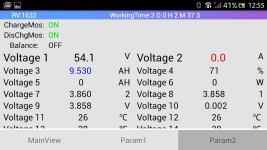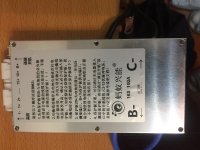Frustrating mystery from this weekend. Bottom line, 5/14ths of my pack is dead, and I don't know what it could be other than some BMS malfunction, although I haven't pinned it down. BMS is
this one, 14s 30 A.
I hadn't used my ebike in a couple months, although I connected via Bluetooth once per week or so. I figured that connection meant that things were probably OK, but I should have tapped over to the Battery State screen...
This weekend I wanted to fire it up, but when I connected and unlocked the FETs, I got the "IC front end error". It was reporting a pack voltage of 1.5 V. Shit.
I disconnected the battery and took it down to the workshop and cut off the shrinkwrap. The voltage at the terminals was indeed 1.5 V, but when I measured from the input side of the BMS instead of the output, I got 36 V. Whew, so not a total loss. 2.6 V/group means there's a current drain somewhere I have to track down, but the battery is still usable. Just have to charge it up and see if that resets the "IC front end error", whatever that means.
Connected the charger, no current. The FETs were still closed. Tried opening them with JBD Tools, no luck. Meanwhile, the BMS was still reporting nonsense voltages on all the groups.
Measuring the pins on the balance connector, it turned out that the pack wasn't at 2.6 V/group. Instead, the top 9 groups were at 4 V each (where I had left them when I charged last), and the lower 5 were at zero.
I did a quick visual to see if there were any shorts between the groups, but I couldn't see anything. And since I had closed the FETs while it was being stored, there shouldn't have been any external load, and if there were it should have drained the groups uniformly. The only thing connected to individual groups was the balance wires.
Not sure where to go from here in terms of diagnosis, but I have 10 GA cells with 3 cycles on them that are now useless. This is frustrating on its own terms, but I'm also concerned since I have a similar BMS on my scooter, which is a much larger pack. I have been regularly checking the cell voltages on this pack, and so far so good, but it makes me less confident about leaving the BMS attached to any pack of significant value.
Now, having vented my frustration, in 1k+ posts on this thread I think there's only been one other catastrophic failure (due to an endless balancing loop, IIRC), so I'm not recommending that anyone throw these in the bin. Just providing some anecdata and hoping it sparks some thoughts that could help me figure out what went wrong and help others to avoid a similar circumstance.



